child seat FORD E SERIES 2013 4.G User Guide
[x] Cancel search | Manufacturer: FORD, Model Year: 2013, Model line: E SERIES, Model: FORD E SERIES 2013 4.GPages: 416, PDF Size: 4.29 MB
Page 24 of 416
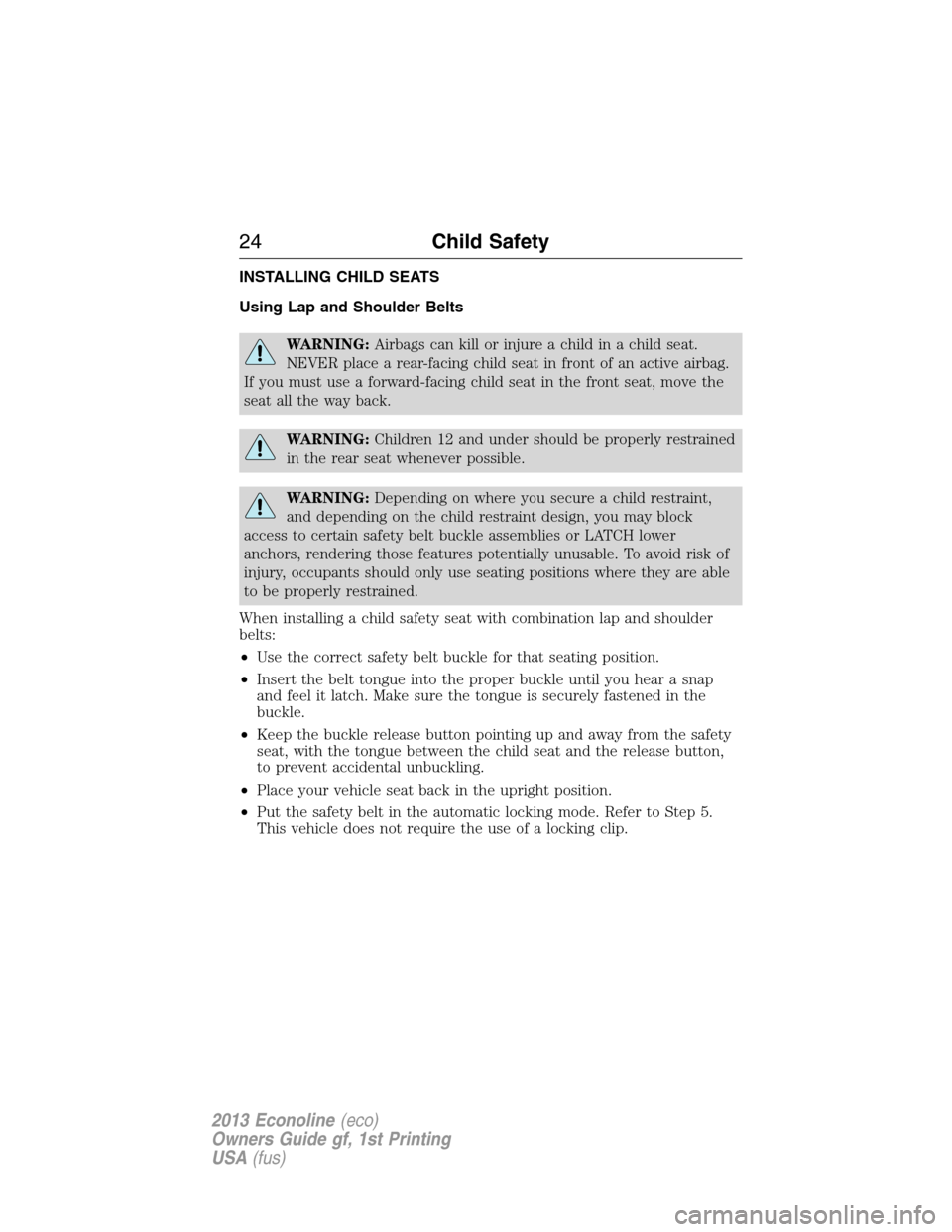
INSTALLING CHILD SEATS
Using Lap and Shoulder Belts
WARNING:Airbags can kill or injure a child in a child seat.
NEVER place a rear-facing child seat in front of an active airbag.
If you must use a forward-facing child seat in the front seat, move the
seat all the way back.
WARNING:Children 12 and under should be properly restrained
in the rear seat whenever possible.
WARNING:Depending on where you secure a child restraint,
and depending on the child restraint design, you may block
access to certain safety belt buckle assemblies or LATCH lower
anchors, rendering those features potentially unusable. To avoid risk of
injury, occupants should only use seating positions where they are able
to be properly restrained.
When installing a child safety seat with combination lap and shoulder
belts:
•Use the correct safety belt buckle for that seating position.
•Insert the belt tongue into the proper buckle until you hear a snap
and feel it latch. Make sure the tongue is securely fastened in the
buckle.
•Keep the buckle release button pointing up and away from the safety
seat, with the tongue between the child seat and the release button,
to prevent accidental unbuckling.
•Place your vehicle seat back in the upright position.
•Put the safety belt in the automatic locking mode. Refer to Step 5.
This vehicle does not require the use of a locking clip.
24Child Safety
2013 Econoline(eco)
Owners Guide gf, 1st Printing
USA(fus)
Page 25 of 416

Perform the following steps when installing the child seat with lap and
shoulder belts:
Note:Although the child seat illustrated is a forward facing child seat,
the steps are the same for installing a rear facing child seat.
1. Position the child safety seat in a
seat with a combination lap and
shoulder belt.
2. Pull down on the shoulder belt
and then grasp the shoulder belt
and lap belt together.
3. While holding the shoulder and
lap belt portions together, route the
tongue through the child seat
according to the child seat
manufacturer’s instructions. Be sure
the belt webbing is not twisted.
Child Safety25
2013 Econoline(eco)
Owners Guide gf, 1st Printing
USA(fus)
Page 26 of 416
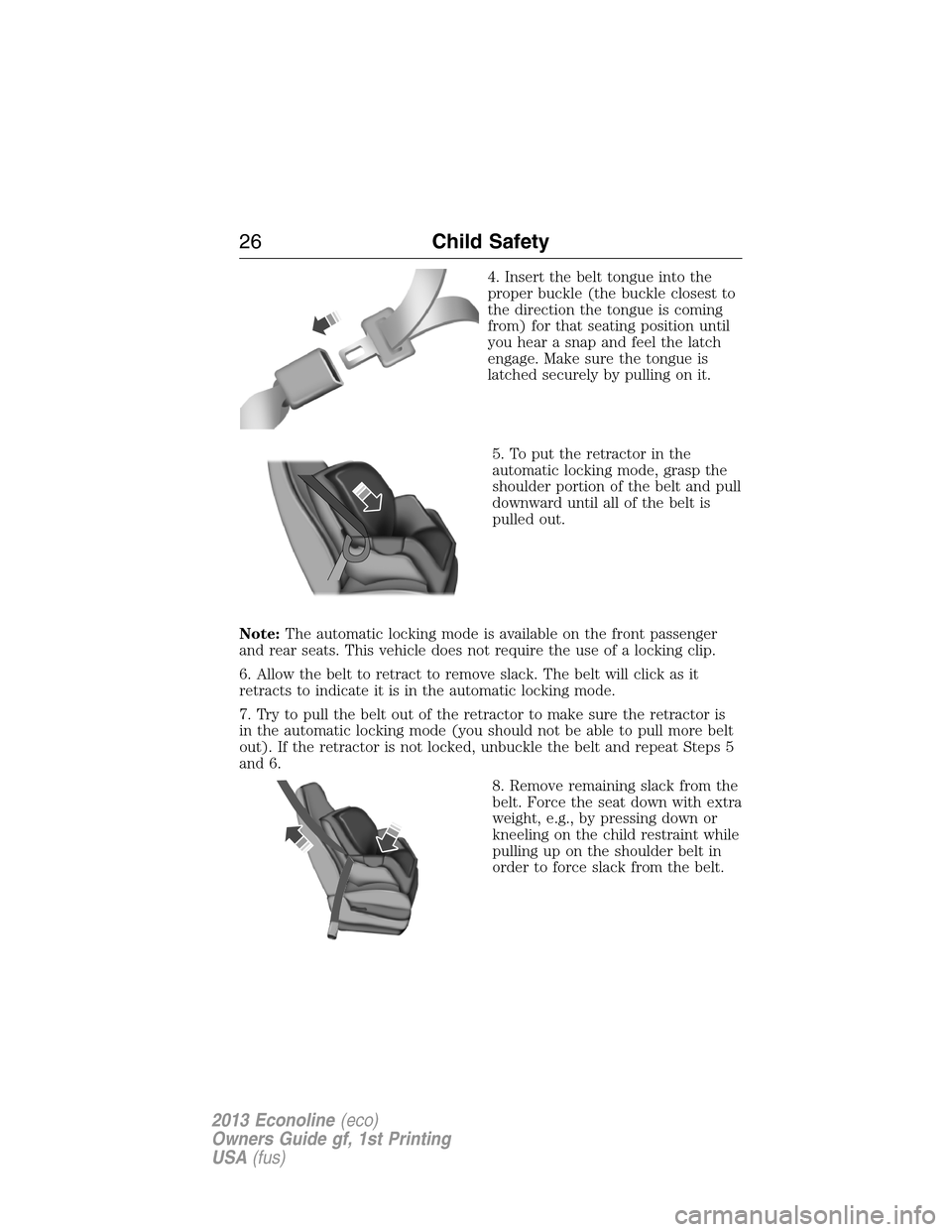
4. Insert the belt tongue into the
proper buckle (the buckle closest to
the direction the tongue is coming
from) for that seating position until
you hear a snap and feel the latch
engage. Make sure the tongue is
latched securely by pulling on it.
5. To put the retractor in the
automatic locking mode, grasp the
shoulder portion of the belt and pull
downward until all of the belt is
pulled out.
Note:The automatic locking mode is available on the front passenger
and rear seats. This vehicle does not require the use of a locking clip.
6. Allow the belt to retract to remove slack. The belt will click as it
retracts to indicate it is in the automatic locking mode.
7. Try to pull the belt out of the retractor to make sure the retractor is
in the automatic locking mode (you should not be able to pull more belt
out). If the retractor is not locked, unbuckle the belt and repeat Steps 5
and 6.
8. Remove remaining slack from the
belt. Force the seat down with extra
weight, e.g., by pressing down or
kneeling on the child restraint while
pulling up on the shoulder belt in
order to force slack from the belt.
26Child Safety
2013 Econoline(eco)
Owners Guide gf, 1st Printing
USA(fus)
Page 27 of 416
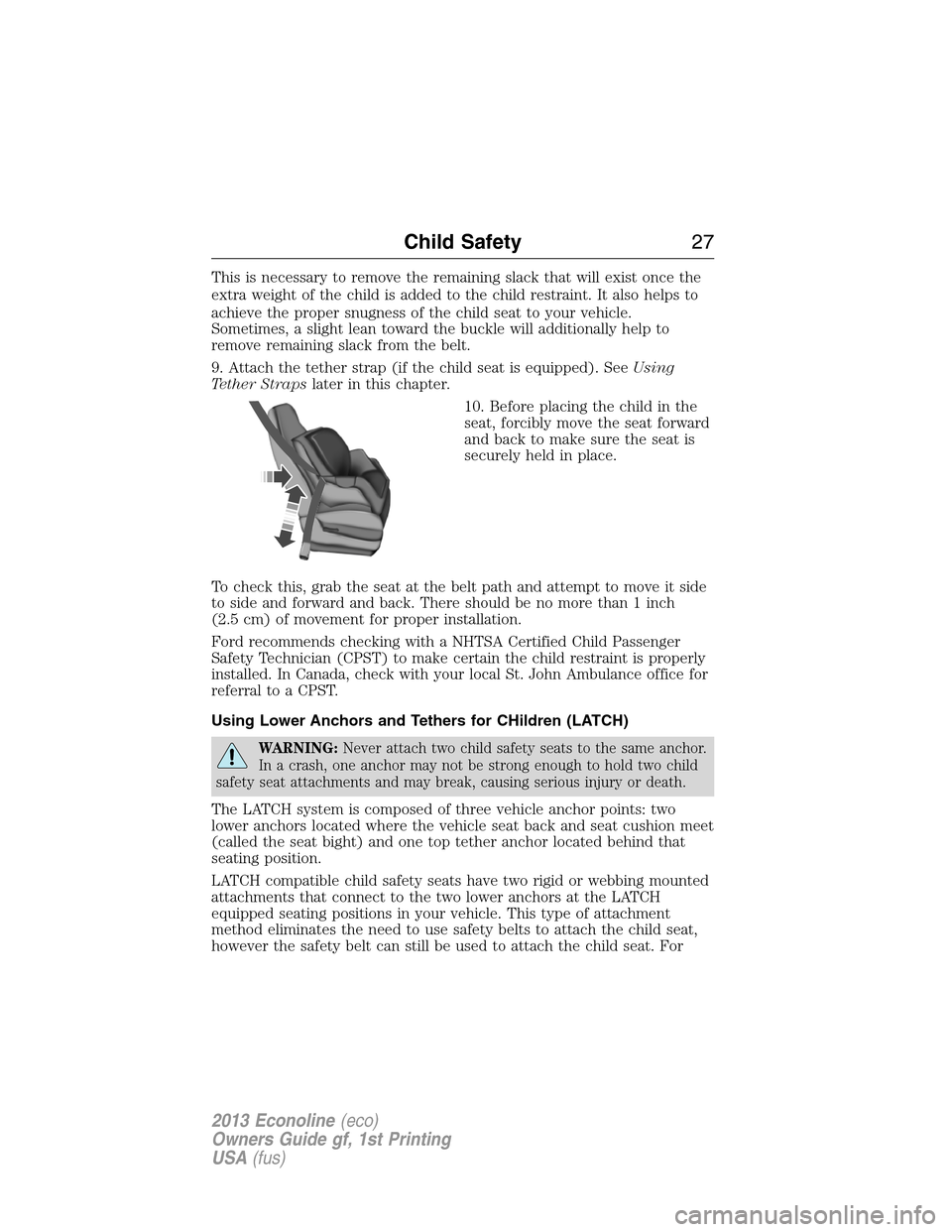
This is necessary to remove the remaining slack that will exist once the
extra weight of the child is added to the child restraint. It also helps to
achieve the proper snugness of the child seat to your vehicle.
Sometimes, a slight lean toward the buckle will additionally help to
remove remaining slack from the belt.
9. Attach the tether strap (if the child seat is equipped). SeeUsing
Tether Strapslater in this chapter.
10. Before placing the child in the
seat, forcibly move the seat forward
and back to make sure the seat is
securely held in place.
To check this, grab the seat at the belt path and attempt to move it side
to side and forward and back. There should be no more than 1 inch
(2.5 cm) of movement for proper installation.
Ford recommends checking with a NHTSA Certified Child Passenger
Safety Technician (CPST) to make certain the child restraint is properly
installed. In Canada, check with your local St. John Ambulance office for
referral to a CPST.
Using Lower Anchors and Tethers for CHildren (LATCH)
WARNING:Never attach two child safety seats to the same anchor.
In a crash, one anchor may not be strong enough to hold two child
safety seat attachments and may break, causing serious injury or death.
The LATCH system is composed of three vehicle anchor points: two
lower anchors located where the vehicle seat back and seat cushion meet
(called the seat bight) and one top tether anchor located behind that
seating position.
LATCH compatible child safety seats have two rigid or webbing mounted
attachments that connect to the two lower anchors at the LATCH
equipped seating positions in your vehicle. This type of attachment
method eliminates the need to use safety belts to attach the child seat,
however the safety belt can still be used to attach the child seat. For
Child Safety27
2013 Econoline(eco)
Owners Guide gf, 1st Printing
USA(fus)
Page 28 of 416
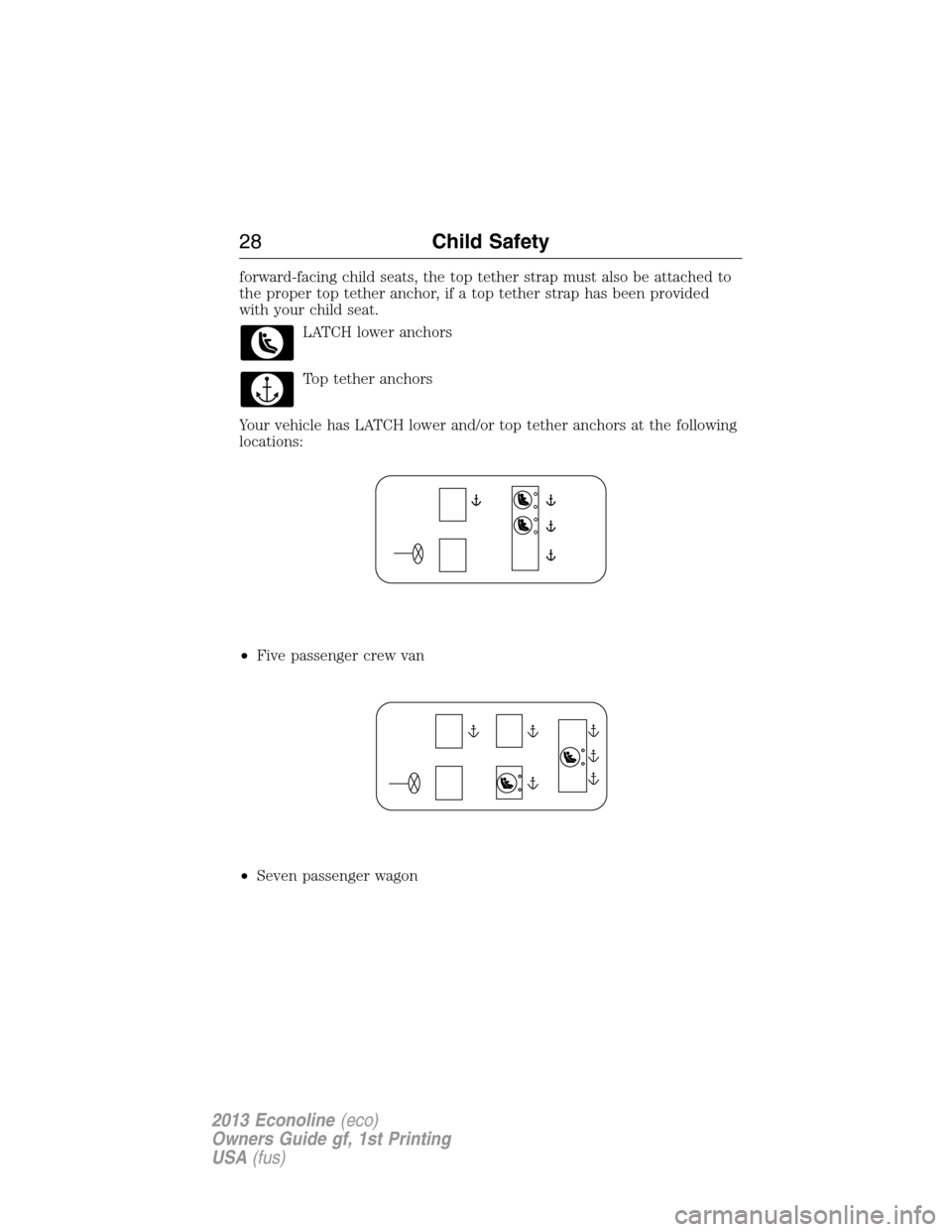
forward-facing child seats, the top tether strap must also be attached to
the proper top tether anchor, if a top tether strap has been provided
with your child seat.
LATCH lower anchors
Top tether anchors
Your vehicle has LATCH lower and/or top tether anchors at the following
locations:
•Five passenger crew van
•Seven passenger wagon
28Child Safety
2013 Econoline(eco)
Owners Guide gf, 1st Printing
USA(fus)
Page 30 of 416
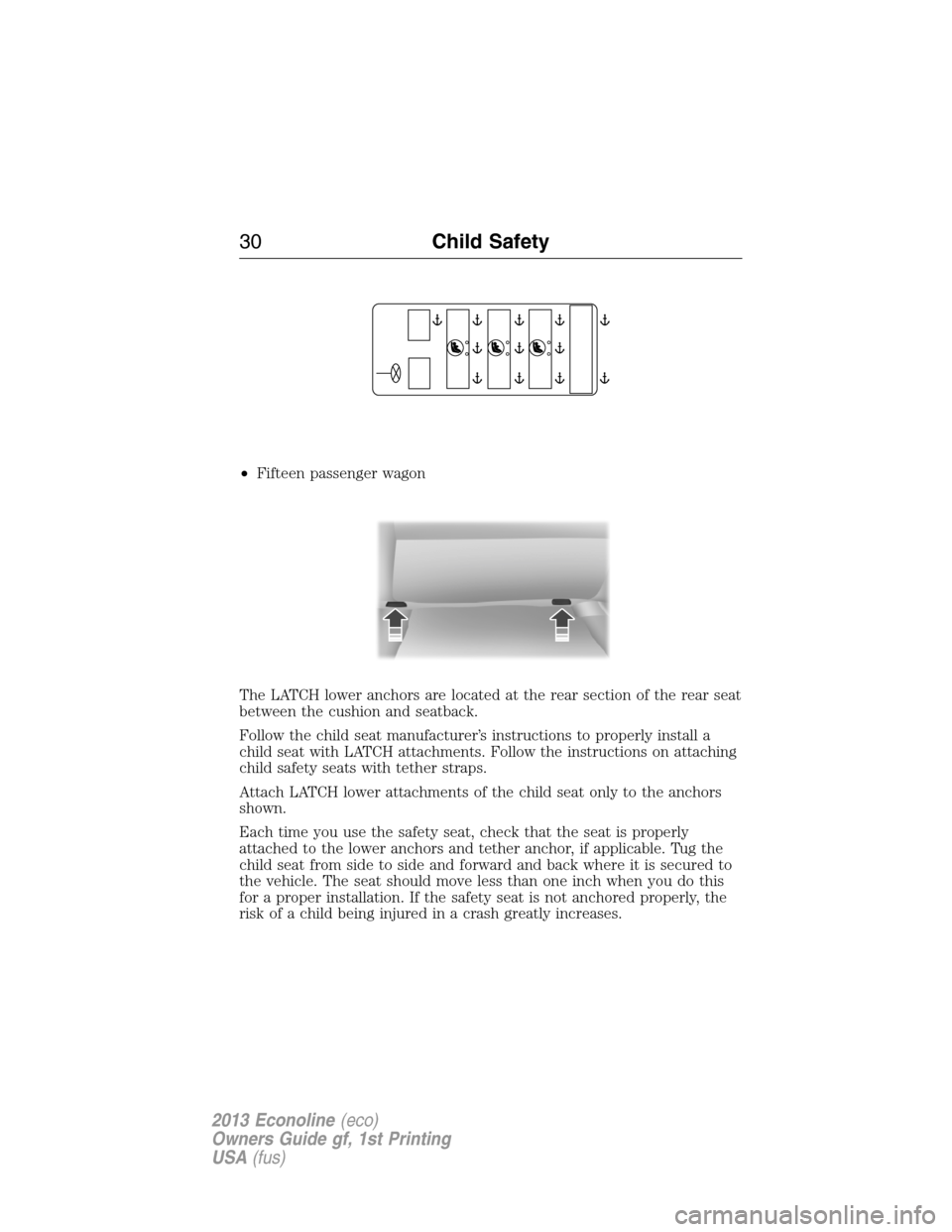
•Fifteen passenger wagon
The LATCH lower anchors are located at the rear section of the rear seat
between the cushion and seatback.
Follow the child seat manufacturer’s instructions to properly install a
child seat with LATCH attachments. Follow the instructions on attaching
child safety seats with tether straps.
Attach LATCH lower attachments of the child seat only to the anchors
shown.
Each time you use the safety seat, check that the seat is properly
attached to the lower anchors and tether anchor, if applicable. Tug the
child seat from side to side and forward and back where it is secured to
the vehicle. The seat should move less than one inch when you do this
for a proper installation. If the safety seat is not anchored properly, the
risk of a child being injured in a crash greatly increases.
30Child Safety
2013 Econoline(eco)
Owners Guide gf, 1st Printing
USA(fus)
Page 31 of 416
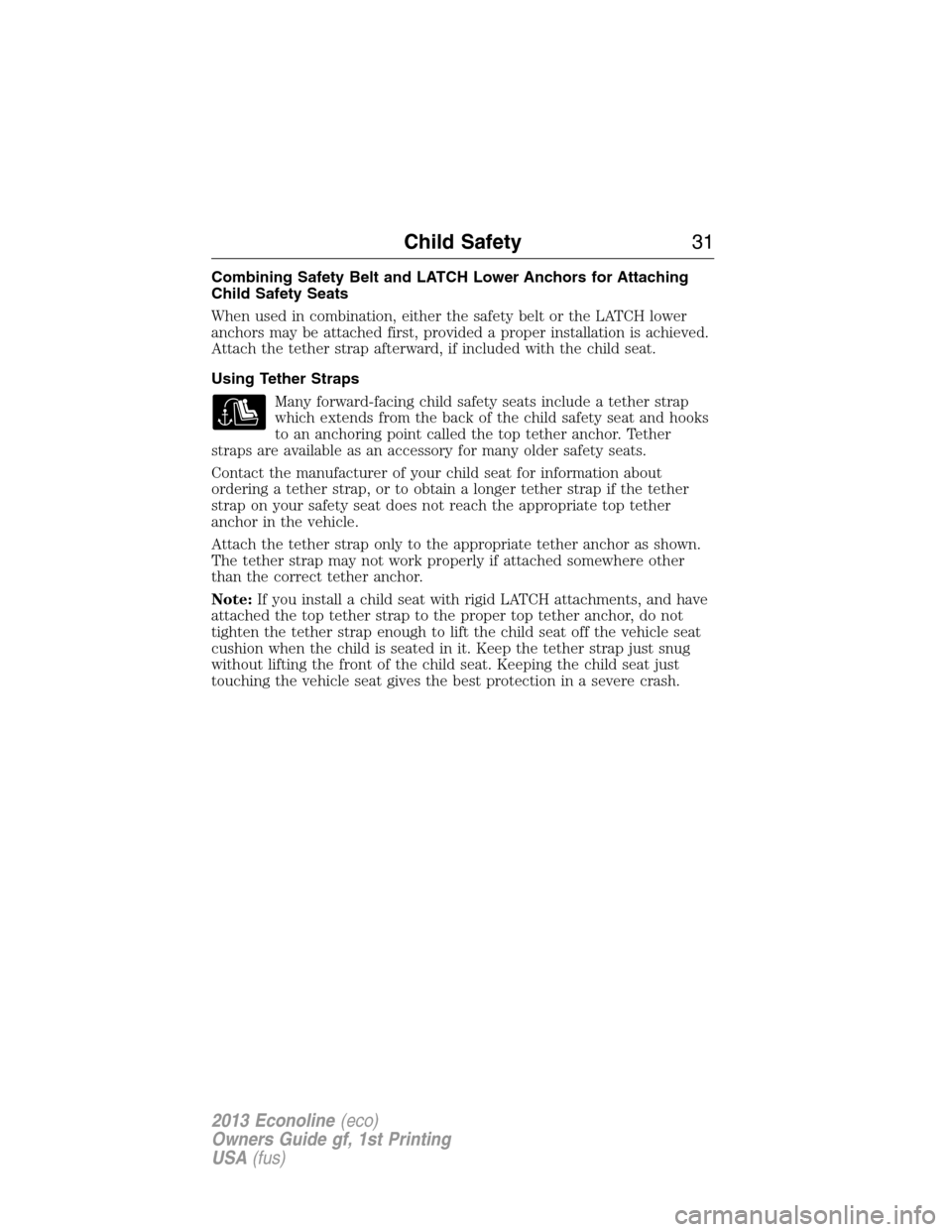
Combining Safety Belt and LATCH Lower Anchors for Attaching
Child Safety Seats
When used in combination, either the safety belt or the LATCH lower
anchors may be attached first, provided a proper installation is achieved.
Attach the tether strap afterward, if included with the child seat.
Using Tether Straps
Many forward-facing child safety seats include a tether strap
which extends from the back of the child safety seat and hooks
to an anchoring point called the top tether anchor. Tether
straps are available as an accessory for many older safety seats.
Contact the manufacturer of your child seat for information about
ordering a tether strap, or to obtain a longer tether strap if the tether
strap on your safety seat does not reach the appropriate top tether
anchor in the vehicle.
Attach the tether strap only to the appropriate tether anchor as shown.
The tether strap may not work properly if attached somewhere other
than the correct tether anchor.
Note:If you install a child seat with rigid LATCH attachments, and have
attached the top tether strap to the proper top tether anchor, do not
tighten the tether strap enough to lift the child seat off the vehicle seat
cushion when the child is seated in it. Keep the tether strap just snug
without lifting the front of the child seat. Keeping the child seat just
touching the vehicle seat gives the best protection in a severe crash.
Child Safety31
2013 Econoline(eco)
Owners Guide gf, 1st Printing
USA(fus)
Page 32 of 416
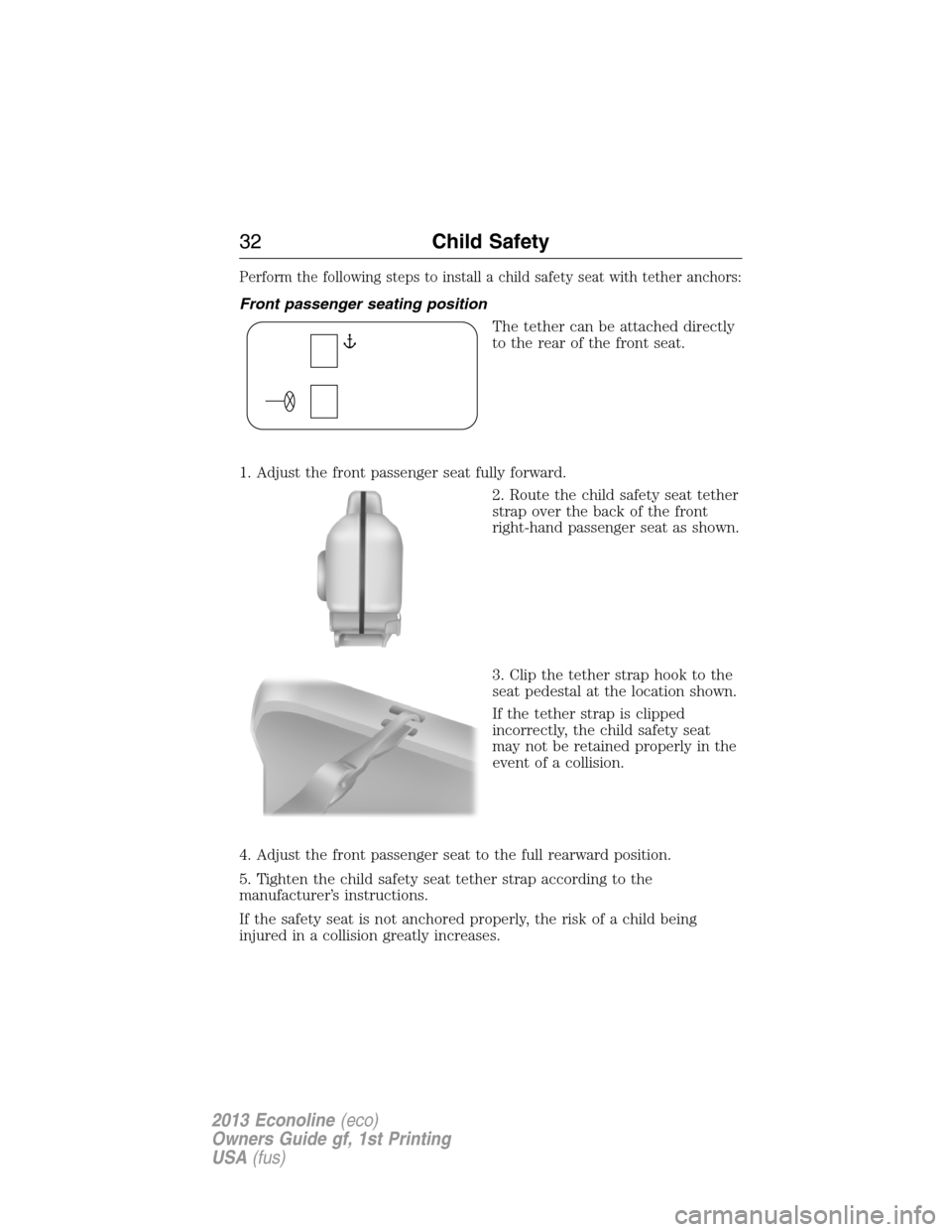
Perform the following steps to install a child safety seat with tether anchors:
Front passenger seating position
The tether can be attached directly
to the rear of the front seat.
1. Adjust the front passenger seat fully forward.
2. Route the child safety seat tether
strap over the back of the front
right-hand passenger seat as shown.
3. Clip the tether strap hook to the
seat pedestal at the location shown.
If the tether strap is clipped
incorrectly, the child safety seat
may not be retained properly in the
event of a collision.
4. Adjust the front passenger seat to the full rearward position.
5. Tighten the child safety seat tether strap according to the
manufacturer’s instructions.
If the safety seat is not anchored properly, the risk of a child being
injured in a collision greatly increases.
32Child Safety
2013 Econoline(eco)
Owners Guide gf, 1st Printing
USA(fus)
Page 33 of 416
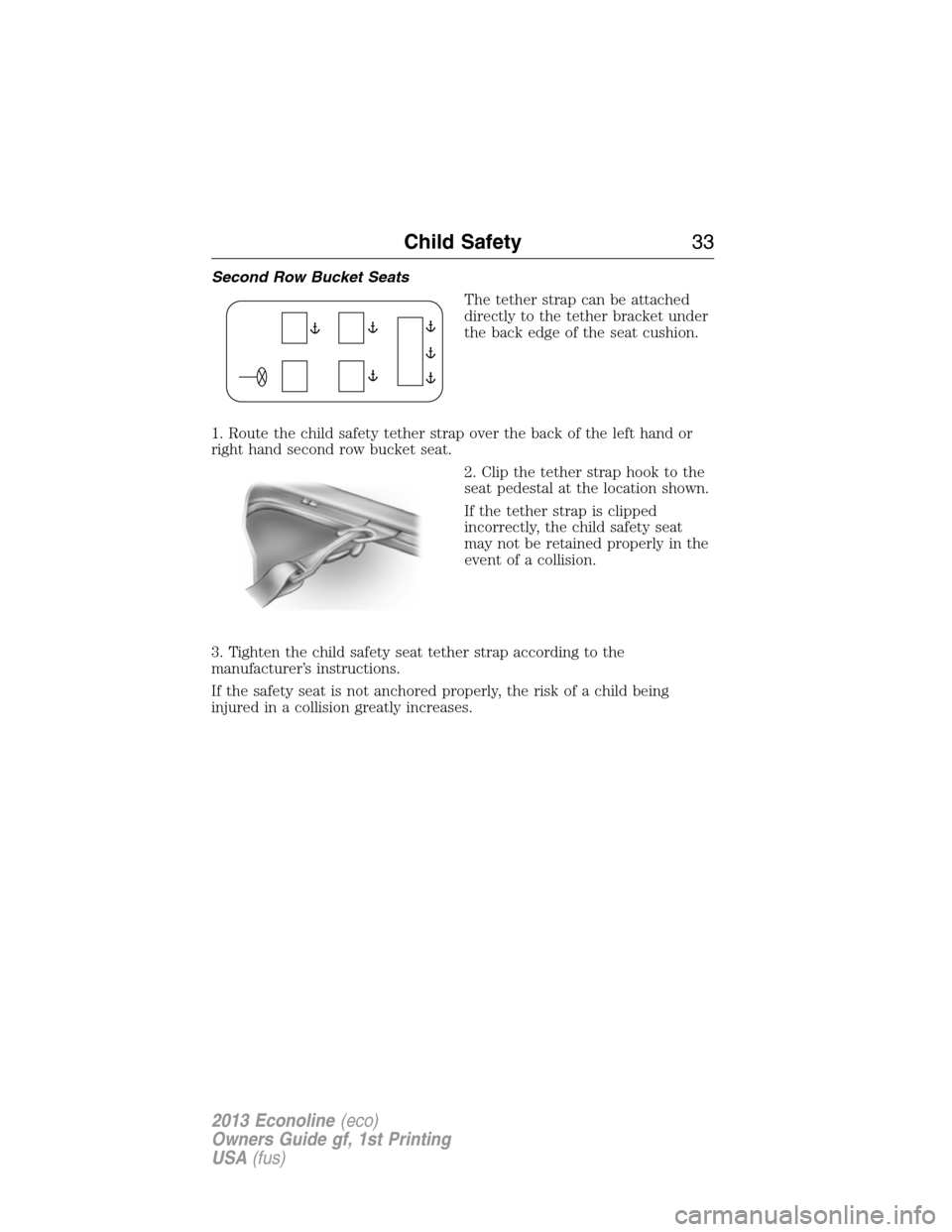
Second Row Bucket Seats
The tether strap can be attached
directly to the tether bracket under
the back edge of the seat cushion.
1. Route the child safety tether strap over the back of the left hand or
right hand second row bucket seat.
2. Clip the tether strap hook to the
seat pedestal at the location shown.
If the tether strap is clipped
incorrectly, the child safety seat
may not be retained properly in the
event of a collision.
3. Tighten the child safety seat tether strap according to the
manufacturer’s instructions.
If the safety seat is not anchored properly, the risk of a child being
injured in a collision greatly increases.
Child Safety33
2013 Econoline(eco)
Owners Guide gf, 1st Printing
USA(fus)
Page 34 of 416
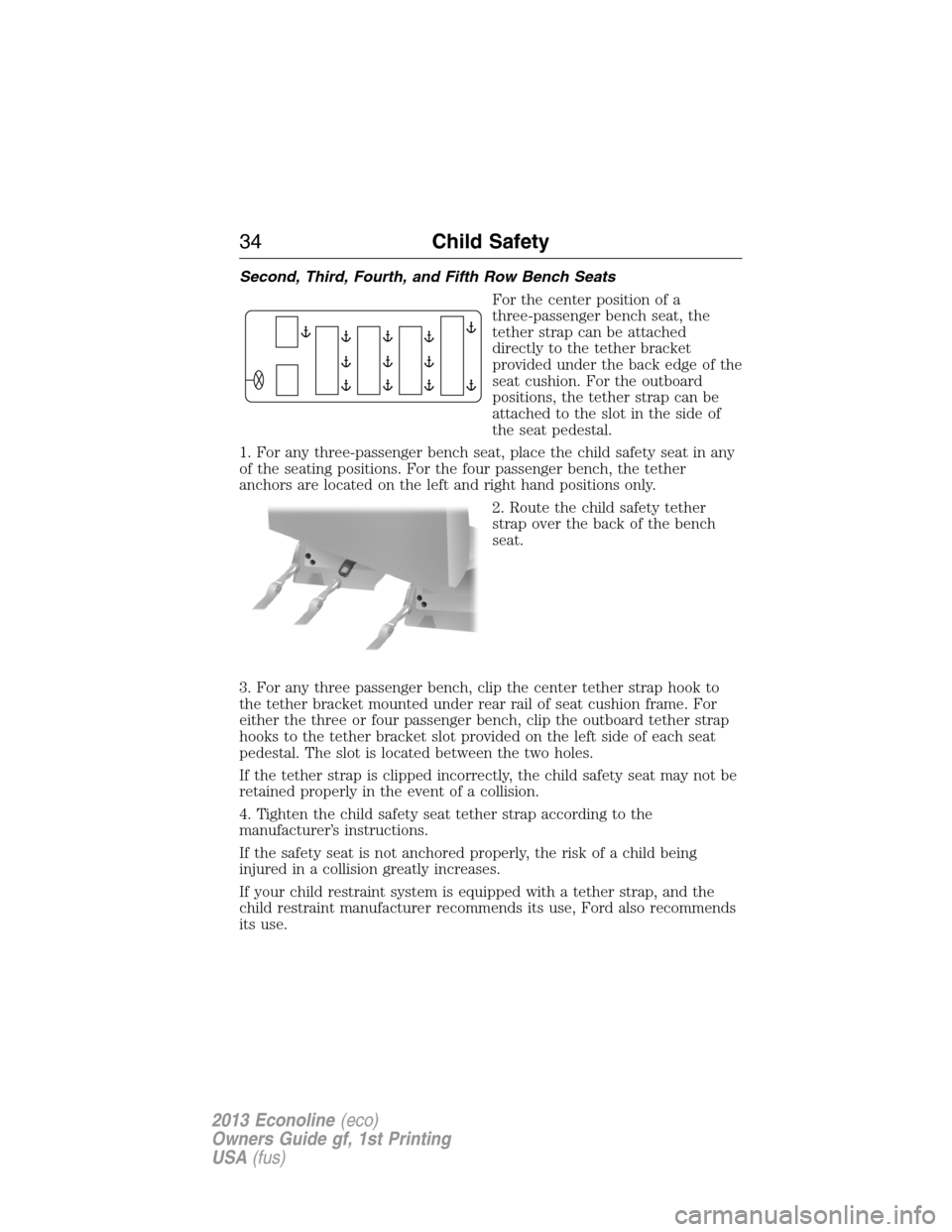
Second, Third, Fourth, and Fifth Row Bench Seats
For the center position of a
three-passenger bench seat, the
tether strap can be attached
directly to the tether bracket
provided under the back edge of the
seat cushion. For the outboard
positions, the tether strap can be
attached to the slot in the side of
the seat pedestal.
1. For any three-passenger bench seat, place the child safety seat in any
of the seating positions. For the four passenger bench, the tether
anchors are located on the left and right hand positions only.
2. Route the child safety tether
strap over the back of the bench
seat.
3. For any three passenger bench, clip the center tether strap hook to
the tether bracket mounted under rear rail of seat cushion frame. For
either the three or four passenger bench, clip the outboard tether strap
hooks to the tether bracket slot provided on the left side of each seat
pedestal. The slot is located between the two holes.
If the tether strap is clipped incorrectly, the child safety seat may not be
retained properly in the event of a collision.
4. Tighten the child safety seat tether strap according to the
manufacturer’s instructions.
If the safety seat is not anchored properly, the risk of a child being
injured in a collision greatly increases.
If your child restraint system is equipped with a tether strap, and the
child restraint manufacturer recommends its use, Ford also recommends
its use.
34Child Safety
2013 Econoline(eco)
Owners Guide gf, 1st Printing
USA(fus)